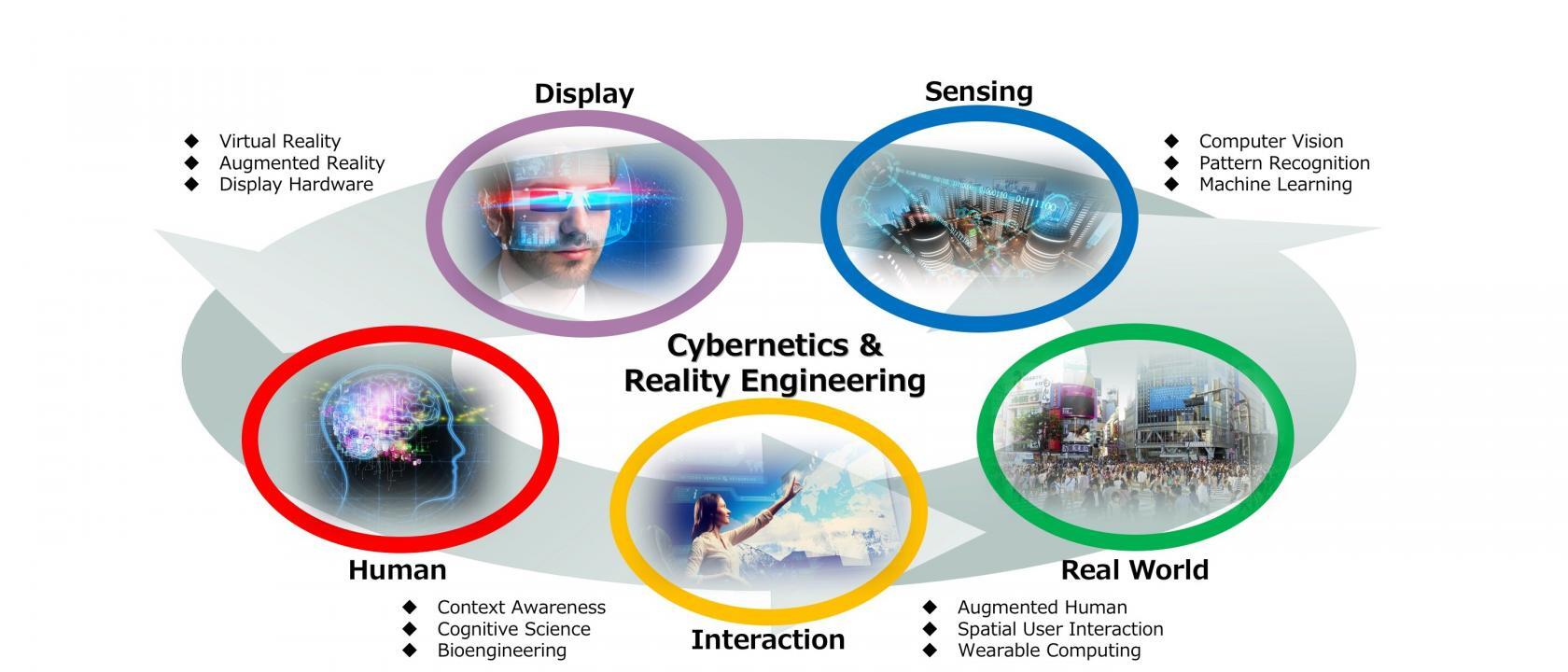CARE Lab’s Mission ~ Beyond AR & VR ~
Welcome to the website of Cybernetics and Reality Engineering Laboratory (CARE Lab), Division of Information Science, Graduate School of Science and Technology, Nara Institute of Science and Technology, Japan.
Cybernetics is an academic field that unifies humans and systems. Reality Engineering is used in the meaning of a superordinate concept bundling every engineering technologies that modulate the sense of reality humans perceive including virtual reality (VR), augmented reality (AR), mixed reality (MR) and so on. In this laboratory, we are studying all of these, especially sensing, display and interaction technologies.
Humans have acquired new capabilities by inventing various tools long before computers came up and mastering them as if they were part of the body. In this laboratory, we conduct research to create “tools of the future” by making full use of AR and VR technologies, human and environmental sensing, sensory representation, wearable computing, context awareness, machine learning, biological information processing and other technologies. In particular, by manipulating various sensations such as vision, we aim to live more conveniently, more comfortably, or more securely by offering “personalized reality” which empathizes each person. Through such information systems, we would like to contribute to the realization of an inclusive society where all people can maximize their abilities and help each other.
CARE, an abbreviation for a laboratory, also has the meaning of caring for and helping people.
Our laboratory has newly been established in April 2017. We will continue to try new challenges, inheriting the assets of Vision and Media Computing Laboratory.
For those who are interested in CARE Lab
NAIST is a graduate school-only institute that supports people who want to take on new challenges. We open our doors to everyone and look forward to your visit.
- Want to know research themes and publications: See our projects and publications.
- Want to join, visit, inquire: See the ”Join us” page. You can find a Contact Form too.
- Want to know general activities: See our news by clicking the logo on top or from here.
Introduction Movies to the Laboratory (in Japanese)
Greetings from Lab Staff (2023)
About Logo of the Laboratory

This logo expresses the concept of ‘Personalized reality’ that gently wraps people with reality colored with bits, close to each individual.
Digest of Prof. Kiyokawa’s Activities
Here is a super compact summary of my activities. I’ve been doing research on augmented reality (AR) and virtual reality (VR) since 1994, and in recent years I’ve been interested in research on human augmentation based on these technologies. I am not only interested in the basic research of AR and VR, but also in the integration of these technologies and the peripheral technologies based on them to revolutionize society as a whole, so that each individual can live more vibrantly.
Please see here for a list of my research achievements and social contributions.
- IEEE VGTC VR Awards won the triple crown(2022.03)
I have been awarded my IEEE VGTC VR Technical Achievement Award for my pioneering research achievements in virtual reality (VR) and augmented reality (AR). I have also been awarded my IEEE VGTC VR Service Award, which was established this year, for many years of my contribution to the management of the academic community in the field. Due to these achievements, I was elected as an inaugural inductee of the IEEE VGTC VR Academy. I am very honored to receive multiple prestigious awards at the same time. I would like to continue to contribute to the development of the field. - Report on the IEEE VR 2019 (2019.09)
This is a Japanese report on the IEEE Virtual Reality and 3D User Interfaces (VR) 2019, a top conference in the virtual reality field held in Japan for the first time in 18 years (p.5-p.7). I served as a general chair. We welcomed and entertained many researchers from around the world by a variety of academic and social events such as Osaka Gourmet Night, which rented out the entire Kuromon Market, a public market representing Osaka. - “VR has a surprisingly long history, and students recreate incontinence and sticky feelings” (2018.08)
This is a report on a Japanese lecture at the VR Research Group, an organization founded by Dell Japan to promote the spread of VR for industrial use. It summarizes the history of virtual reality in Japan since the 1980s and the activities of the Virtual Reality Society of Japan, which was founded in 1996. - “Manipulating Reality to Create New Capabilities”, CARE Lab Introduction, NAIST Edge (2017.07)
This is a short Japanese introduction to our laboratory on Edge. Edge is a web-based media where NAIST faculty members introduce their research in relays. - VR Technology Roadmap: “Virtual Reality Opens the Way to a Worth-Living Society” (2013.12)
This is a technology roadmap to 2040, created by young members of the Virtual Reality Society of Japan. It is claimed that it is possible to create a society where people have a sense of fulfillment. The mission of our laboratory, “to create new abilities by manipulating a sense of reality to make people happy,” was born out of a strong sympathy for this roadmap, which I happened to be in charge of coordinating.
Here is an unofficial English version. - Preface of the Journal of the Virtual Reality Society of Japan, “Recommendations for Aggressive International Exchange” (2013.12)
This is a Japanese message mainly for students, encouraging them to take an easy and positive approach to international exchange. - The 10th Anniversary Symposium of the Virtual Reality Society of Japan “The Future of VR” (2006.09)
The 10th Anniversary of the VRSJ Special Issue “~ Virtual VR – Virtualizing VR Technology” (2006.09)
Virtual Reality is defined as “existing or resulting in essence or effect, though not in actual fact or form”; simply put, it is “the essence of reality”. I defined “Virtual VR” as a technology with “the essence of VR”, or “VR in essence or effect, though not in actual fact or form” and predicted that Virtual VR will spread in the future. It may be said to be a prediction of the development of today’s XR-related technologies. - ISMR ’99 Participation Report (1999.06)
Prof. Milgram of the University of Toronto proposed the concept of Mixed Reality (MR) in 1994, but this may have been the first time for me to hear about its contents in person. It was the event that made me realize once again the great potential of AR, MR and VR, and it was the event that led to my being stuck in this field. For your reference, by the original definition, MR is a combination of Augmented Reality (AR) and Augmented Virtuality (AV), and VR is not included in MR. - “VLEGO: A Simple Two-handed Modeling Environment Based on Toy Blocks”(preprint/ACM DL), ACM VRST 1996 (1996.07)
This was almost the first time for me to present my work at an international conference. I entered NAIST in 1994 and was a D1 student in 1996. It was on a VR design tool that allows anyone to design in the air with intuitive interaction techniques mimicking Lego block toys. After eating a lot of good food in Hong Kong, I realized that there is no more fun profession than being a researcher. - Fujitsu Pavilion at Tsukuba Science Expo (YouTube movie/technical material) (1985)
The Universe, a fulldome 3-D image that I saw at the Fujitsu Pavilion at Tsukuba Science Expo, changed my life. Without a doubt, it inspired me to pursue virtual reality. - Osaka Municipal Electric Science Museum Planetarium (1973?-)
The predecessor of the present Osaka Municipal Science Museum was the Osaka Municipal Electric Science Museum, which had the first planetarium in Japan on the 6th floor. I don’t know how many times I have seen it since I was probably three years old. In a sense, the planetarium is the world’s oldest virtual reality system with autonomy, interaction, and presence.
Related Books on AR & VR Research
Augmented Reality
Here we introduce books on Augmented Reality (AR) that are related to our laboratory. AR is coined by Thomas P. Caudell in 1990 to describe a technology that measures the position of the head and “augments” the user’s visual field with information using a head-up display. In 1997, Ronald Azuma defined AR as systems that have three characteristics; 1) combines real and virtual, 2) interactive in real-time, and 3) registered in 3D.
- “Augmented Reality: Principles and Practice (Japanese version)” (Mynavi Publishing Co.)

If you want to learn about augmented reality, we recommend reading this book first. Prof. Kiyokawa was a technical reviewer for the original book, and Assoc. Prof. Sakata and several students in our laboratory contributed to the translation. - “Augmented Reality – Theory, Design and Development” (McGraw-Hill)

I would also strongly recommend this book to learn augmented reality which has just been released in August, 2020. The book is extremely rich in information for those who work with their own hands. It may be available only on Amazon India yet, but it is highly rated at 5 stars. Chetankumar G. Shetty, a visiting researcher in our lab, wrote the book and Prof. Kiyokawa collaborated as a technical reviewer. - “Foundation, Development, Practice of Augmented Reality Technology (in Japanese)” (Kagakujyoho Shuppan Co., Ltd.)

I would recommend this book as well. This book explains the theory well and has a lot of practical examples that you can learn while moving your hands. It is a bit expensive though. Prof. Kiyokawa cooperated as one of the editors.
Virtual Reality
Here we introduce a book on Virtual Reality (VR) that is related to our laboratory. It is widely believed that Jaron Lanier coined the term VR in 1987. Actually, the term had been used before that, but Lanier is apparently the one who popularized it. The Virtual Reality Society of Japan has defined VR as “Existing in essence or effect though not in actual fact or form” following the definition of “virtual” in The American Heritage Dictionary. Prof. Susumu Tachi, the first president of the Virtual Reality Society of Japan has identified life-size 3D space, real-time interaction, and self-projection as three elements of VR. On the other hand, David Zeltzer proposed in 1992 that VR has three elements, autonomy, interaction, and presence.
- “Virtual Reality (in Japanese)” (Corona Publishing Co., Ltd.)

If you want to learn about virtual reality, we recommend reading this book first. It was written by many key members of the Virtual Reality Society of Japan. Prof. Kiyokawa partially contributed to the work too. - “Head-Mounted Displays (in Japanese)” (Corona Publishing Co.)

This book provides a clear summary of topics ranging from the basics to the latest discussions on head-mounted displays. In 2024, instead of publishing a revised edition of the abovementioned “Virtual Reality”, the Virtual Reality Society of Japan began publishing the “Virtual Reality Library”, a series of volumes each covering a specific topic related to virtual reality. Prof. Kiyokawa serves as the chief editor of this series. Two volumes, “Head-Mounted Displays” and “Neural Stimulation Interfaces,” have already been published, with several more in preparation. Stay tuned for upcoming releases!
Research Partners
We conduct a variety of research collaborations, application developments etc. together with many research institutes and companies including those below.
- Division of Integrated Media Environment (Takemura Lab.), Osaka University, Japan
- Life Engineering Laboratory (Kuroda Lab.), University of Tsukuba, Japan
- Tsukamoto Terada Laboratory, Kobe University, Japan
- Ambient Mechatronics Lab (Yoshimoto Group), The University of Tokyo, Japan
- Interactive Content Design Laboratory (Kitamura Lab.), Tohoku University, Japan
- Augmented Vision Laboratory (Itoh Lab.), Tokyo Institute of Technology, Japan
- SENS Laboratory (Sato Lab.), Osaka University, Japan
- Spatial Augmented Reality Laboratory (Amano Lab.), Wakayama University, Japan
- Cyber Interface Laboratory (Kuzuoka, Amemiya, Narumi Lab.), The University of Tokyo, Japan
- Yanai Laboratory, The University of Electro-Communications, Japan
- Virtual Communication Design Laboratory (Yonezawa Lab.), Kansai University
- Social Informatics Laboratory (Hijikata Lab), School of Business Administration, Kwansei Gakuin University
- Institute of Visual Computing (Prof. Kruijff), Bonn-Rhein-Sieg University of Applied Sciences, Germany
- Computer Aided Medical Procedures & Augmented Reality (CAMPAR) (Prof. Klinker, Prof. Navab), The Technical University of Munich, Germany
- Institute of Communications Engineering (Prof. Minker), Ulm University, Germany
- Hybrid Team (Dr. Lecuyer), INRIA Rennes/IRISA, France
- Potioc Team (Dr. Hachet), INRIA Bordeaux, France
- Visualization Lab (Prof. Belleman), University of Amsterdam, The Netherlands
- Department of Multimedia and Graphic Arts (Prof. Michael-Grigoriou), Cyprus University of Technology, Cyprus
- Digital ART Laboratory (Prof. Yang), Shanghai Jiao Tong University, China
- HITLabNZ (Prof. Lindeman, Prof. Lukosh, Prof. Billinghurst), New Zealand
- Department of Information Science (Prof. Regenbrecht, Prof. Langlotz, Dr. Plopski), University of Otago, New Zealand
- Institute of Computer Graphics and Vision (Prof. Schmalstieg), Graz University of Technology, Austria
- Knowledge Visualization (Prof. Veas), Know-Center, Austria
- 3D Visualization and Imaging Systems Lab (Prof. Hua), The University of Arizona, USA
- School of Information Technology (Prof. Teather), Carleton University, Canada
- TIS Inc.
- Toppan Printing Co. Ltd.
 Intact Green Services, India
Intact Green Services, India
